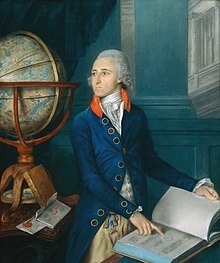John Goodricke
John Goodricke | |
|---|---|
 John Goodricke (Royal Astronomical Society).[1] | |
| Born | 17 September 1764 |
| Died | 20 April 1786 |
| Nationality | British |
| Known for | Studies of variable stars |
| Awards | Copley Medal |
| Scientific career | |
| Fields | Astronomy |
John Goodricke FRS (17 September 1764 – 20 April 1786) was an eminent and profoundly deaf amateur astronomer. He is best known for his observations of the variable star Algol (Beta Persei) in 1782. (In this context, "variable" means that the star changes in brightness.)
Life and work
John Goodricke, named after his grandfather Sir John Goodricke (see Goodricke Baronets of Ribston Hall), was born in Groningen in the Netherlands, but lived most of his life in England. He was profoundly deaf through most of his life, due to scarlet fever in early childhood. His parents sent him to Thomas Braidwood's Academy, a school for the deaf in Edinburgh, and in 1778 to the Warrington Academy.
After leaving Warrington, Goodricke returned to live with his parents in York. There, he became friends with Edward Pigott, whose father Nathaniel Pigott had built a sophisticated private observatory. Edward was already interested in variable stars, and he gave Goodricke a list of those that he thought were worthy of observation.
Although several stars were already known to vary in apparent magnitude, Goodricke was the first to propose a mechanism to account for this. He suggested that Algol is what is now known as an eclipsing binary. He presented his findings to the Royal Society in May 1783, and for this work, the Society awarded him the Copley Medal for that year. He was elected a Fellow of the Royal Society on 16 April 1786. He never learned of this honour however, as he died four days later, probably from pneumonia. He never married.
Goodricke in Yorkshire
Goodricke was buried at Hunsingore Church in Yorkshire, along with many of his relatives.[2]
Today there is a marker in York near the site of John Goodricke's observatory.
Between October 2005 and March 2006 Sean Ellingham and James Valner from the University of York undertook a project to find the position of Goodricke's observatory using the data he recorded. A 1949 study by Sidney Melmore[3] had shown that Goodricke worked from the Treasurer's House (now owned by the National Trust) very near York Minster. By re-creating Goodricke's observations, the two York students were able to conclude that he had observed from the eastern-most window of the second floor, looking south towards the Minster.
Goodricke College at the University of York is named after Goodricke. There is also a modern sculpture named Algol in the grounds.
References
- ^ This portrait is attributed to James Scouler (ca. 1740 – 1812), and was given to the Royal Astronomical Society in 1912. See "John Goodricke". The Observatory. 12 (12): 435–436. 1912. Uncropped, sharper copies of the painting are at the Science Photo Library and also at this site about the Goodricke family.
- ^ Goodricke, C. A. (1912). "Letter accompanying the gift to the Society of a portrait of John Goodricke". Monthly Notices of the Royal Astronomical Society. 73 (11): 3–4.
- ^ Melmore, Sydney (1949). "The Site of John Goodricke's Observatory". The Observatory. 65: 95–99.
Further reading
- Gilman, Carolyn (1978). "John Goodricke and His Variable Stars". Sky and Telescope. 56 (11): 400–403.
- Goodricke, John (1784). "On the Periods of the Changes of Light in the Star Algol. In a Letter from John Goodricke, Esq. to the Rev. Anthony Shepherd, D.D.F.R.S. Professor of Astronomy at Cambridge". Philosophical Transactions of the Royal Society of London. 74: 287–292. doi:10.1098/rstl.1784.0023.
- Goodricke, John (1785). "Observations of a New Variable Star. By John Goodricke, Esq.; Communicated by Sir H. C. Englefield, Bart. F. R. S. and A. S.". Philosophical Transactions of the Royal Society of London. 75: 153–164. doi:10.1098/rstl.1785.0009.
{{cite journal}}: Unknown parameter|coauthors=ignored (|author=suggested) (help)
- Goodricke, John (1786). "A Series of Observations on, and a Discovery of, the Period of the Variation of the Light of the Star Marked δ by Bayer, Near the Head of Cepheus. In a Letter from John Goodricke, Esq. to Nevil Maskelyne, D.D.F.R.S. and Astronomer Royal". Philosophical Transactions of the Royal Society of London. 76: 48–61. doi:10.1098/rstl.1786.0002.
External links
- "Goodricke's life and astronomical work".- Features animations of different types of variable stars.
- Goodricke, Michael. "John Goodricke". Retrieved 2009-05-13.
- "Gravesite of John Goodricke". Retrieved 2009-07-03.
